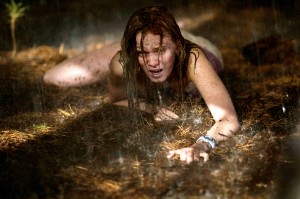 My fellow members of LOTTD are participating in a unity post focused around some recent comments by film critic Roger Ebert. In a film review for The Last House on the Left earlier this month, Ebert made this comment: “Other scenes, while violent, fell within the range of contemporary horror films, which strive to invent new ways to kill people, so the horror fans in the audience will get a laugh.” The focus for our unity post is our reaction to Ebert’s statement. In my commentary that follows I will relate my view that Ebert’s statement is both understandable and correct in a sense, and yet also indicative of an unfortunate stereotype about horror fans.
My fellow members of LOTTD are participating in a unity post focused around some recent comments by film critic Roger Ebert. In a film review for The Last House on the Left earlier this month, Ebert made this comment: “Other scenes, while violent, fell within the range of contemporary horror films, which strive to invent new ways to kill people, so the horror fans in the audience will get a laugh.” The focus for our unity post is our reaction to Ebert’s statement. In my commentary that follows I will relate my view that Ebert’s statement is both understandable and correct in a sense, and yet also indicative of an unfortunate stereotype about horror fans.
Let me begin with articulating how I believe Ebert’s comments are correct and in what senses. At present, teenagers and young adults may comprise the largest demographic segment of horror film audiences. For some time now in developed countries horror films have served as something of a right of passage, functioning as rituals and forms of folklore that serve as a liminal space of gore and violence to be endured on the passage to adult life. Filmmakers are in business to make money, and they understand horror’s primary demographic and their desire to see more violence and gore. When this demographic and its preferences are taken into consideration, and coupled with the dominant underlying philosophy of nihilism in horror films, it should be no surprise that many such films, particularly slasher films or similar cinematic forms of horror, include a heavy emphasis on gore and violence, including depictions of unique ways of killing. With these considerations in mind I think Ebert’s comment is understandable. Many horror fans watching Last House on the Left were probably teens and young adults, and I have no doubt that they did indeed take pleasure in watching the violence on the screens in front of them. But even so, it would be a mistake to say that all horror fans take pleasure in such things.
This leads me to the second part of my response to Ebert’s statement. As a teenager in the 1970s I had a taste for some of the violence in horror at the time. I remember sitting in a theater in California with my brother, and friends, and one friend’s mother as we watched Dawn of the Dead. My friend’s mother came with us because of the rating restriction, and she sat with her eyes closed much of the time while my brother and friends and I watched with glee as zombies ambled about in the mall and alternated between being shot in the head by surviving humans, and chewing body parts off of the humans in their grotesque acts of undead cannibalism. But although the increasing violence of horror films of the 1970s had some appeal for me in the cases of zombie films and Hammer Films’ colorful blood spray, nevertheless, manyof the slasher films and other expressions of horror with gore and violence almost for the sake fo gore and violence did not appeal to me. I have always been attracted to horror with a little more depth and have felt that real fear is generated best by what is not seen or merely suggested rather than what is thrown in the audience member’s face. I know I am not alone in this regard. There is diversity within the viewing audience of horror just as there is diversity in the audience of any particular genre of film. This might be particularly the case with horror films as one moves beyond the teen and young adult demographic. It may be that in the broader representation of horror film audiences there is actually less of a preference for varied depictions of killing with all the violence and gore Hollywood can muster.
I had no interest in The Last House on the Left when the original appeared in 1972, and I have no interest in the remake. This particular formula for horror is not my cup of tea. It is for some, but not for all. In this way it is easy to understand how a noted film critic could be both right in his assessment of horror films, and at the same time wrong in his perpetuation of a stereotype. Personally, I didn’t get my feathers ruffled over Ebert’s comments. I’d rather turn on my DVD player an plop in an offering of my favorite expressions of horror films.
Until next time, the balcony is closed.





I noticed that Ebert did couch his words, saying “contemporary horror films” and the “horror fans in the audience”. Since I don’t like the former and wasn’t one the latter, I take his comments as not applying to me ^_^